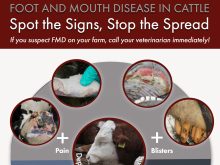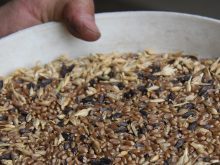Glacier FarmMedia – In 2001, foot-and-mouth disease decimated the U.K.’s beef industry and millions of animals were culled.
According to the BBC, there were 2,000 cases of the disease, which resulted in entire farms having their animals slaughtered. Soldiers dug mass graves and piles of carcasses burned, black smoke billowing into the sky.
Over 20 years later, these images still haunt the U.K. and other countries as the threat of foot-and-mouth looms. In Canada, the BSE outbreak in the early 2000s heightened worries of another disease outbreak.
Read Also

Canada’s slaughter horse industry lacks transparency
The lack of clear reporting and public access to data keeps the industry largely hidden, leaving questions about humane treatment and traceability unanswered.
If a case of foot-and-mouth is confirmed in Canada, what happens next?
Response depend on the size of the outbreak and the number of infected premises. Responders would move as quickly as possible to eradicate the disease in Canada, by both culling animals and possibly administering the foot-and-mouth-disease vaccine.
The effect of even one outbreak in the country would be huge. Borders would close, exports halt, and the beef industry would be crippled, if only momentarily.
That’s why researchers and government officials are working on the response to foot-and-mouth disease now.
At the Saskatchewan Beef Industry Conference in January, experts stand on the stage and field questions from concerned producers, asking about what has been done to prevent a foot-and-mouth outbreak, or what the response will be if an outbreak occurs.
In July 2023, the federal government announced plans to create a vaccine bank for the foot-and-mouth virus, with $57.5 million committed for the first five years.
This comes after years of being involved only in the North American vaccine bank.
Now, experts such as Dr. Tom Smylie, Dr. Sonja Laurendeau and Dr. Andrew Van Kessel, as well as provincial government employees such as Dr. Stephanie Smith, are working on the vaccine bank and the outbreak response.
“This disease would have devastating economic impacts if ever it was introduced into Canada because it would restrict trade for live animals and animal products. And it would also cost a lot of money for disease control efforts,” says Laurendeau, a veterinarian with the Canadian Food Inspection Agency. Laurendeau presented at the Saskatchewan Beef Industry Conference.
Foot-and-mouth is a highly contagious disease that affects cloven-hoofed animals such as cattle, pigs, sheep and deer.
Symptoms include slobbering, shivering, tender and sore feet, blisters on the feet, nose, mouth and udder, raised temperature, reduced milk yield and loss of body condition.
It is spread through direct or indirect contact with infected animals through blood, saliva, milk and feces.
While Canada hasn’t had a case of foot-and-mouth disease since 1952, outbreak concerns have been amplified in recent years due to an increase in the illegal movement of meat into Canada. The virus can survive on raw or partially cooked meat for months.
Van Kessel is the director of research at the Vaccine and Infectious Disease Organization and has been working with other researchers on the foot-and-mouth disease vaccine bank.
He says the vaccine is an intact dead virus cell. This type of vaccine is the only proven technology that works for foot-and-mouth disease.
“One of the disadvantages of this kind of approach is that the dead virus isn’t very stimulatory to the immune system,” Van Kessel says. “And so it needs an adjuvant, it needs a compound that’s added to this dead virus to basically tell the immune system, ‘there’s danger here, you need to respond with your A-team.’ ”
This type of vaccine is also unstable and prone to breakdown, so it must be stored in liquid nitrogen to retain its integrity.
“In order to preserve it, it needs to be stored at least below -87 C,” he says. “And typically, it’s stored in liquid nitrogen at below -150 C. Yes, three times the coldest of a Saskatchewan winter.”
The vaccine only has a 10-month shelf life, so it isn’t stored in anticipation of an outbreak. Instead, the concentrates are stored, and the vaccine would be created if an outbreak happened.
The stored concentrates last for around 10 years at the proper temperature.
Because foot-and-mouth disease is a virus, there are multiple strains. Van Kessel says there are 20 to 25 different antigen concentrates.
“There’s no cross-reactivity. If you are vaccinated with one… you’re not getting protection against another. So basically 20 to 25 strains are required.”
Smylie works at CFIA and has been involved with the vaccine banks.
He says the North American vaccine bank was established between Canada, the United States, and Mexico in 1982. However, Mexico withdrew in 2020. That vaccine bank stores between 10 and 12 strains of antigen concentrates.
Originally the vaccine bank was located on Plum Island in New York State but was moved to Manhattan, Kansas.
Now, the North American vaccines are stored at the manufacturer’s sites in France and Argentina, and are shipped where needed. Australia also stores its own vaccines with the manufacturer.
“Our contracts with these manufacturers say that we will formulate these vaccines into finished vaccines in four to seven days.
And then they will be delivered to us here,” Smylie says.
The foot-and-mouth disease vaccine bank that was announced in the federal budget in 2023 is a vaccine bank for Canada only. Producers have expressed concern about relying on the North American vaccine bank if an outbreak occurs, and for good reason. Smylie says Canada pays 12.5 per cent of the cost of the program to potentially receive 312,500 doses from the North American vaccine bank if an outbreak occurs. Unfortunately, that might not be enough if the outbreak is large.
“Some of the modelling we did a number of years ago in Alberta shows that we would need, for a large outbreak, anywhere between 1.9 and 2.7 million doses to control the outbreak,” Smylie says.
Marie-Claude Bibeau, federal agriculture minister at the time of the announcement, said having a Canadian vaccine bank would make it possible to reduce the spread of the virus by half.
Although the foot-and-mouth disease vaccine is effective, there’s a reason it isn’t used as preventively. Most countries, Canada included, want to be known as foot-and-mouth free, without the vaccine.
Larendeau says if an outbreak were to occur, the CFIA’s response would be “stamping out,” or culling infected animals and disposing of their bodies. Movement control would prevent contact between susceptible animals and zoning would contain the disease agent.
She says there would be three different zones: the infected zone, the restricted zone and the security zone. The infected zone is at least three kilometres from the known infected premises and would likely be the only zone to get vaccinated if vaccination is considered. The restricted zone is at least 10 kilometres from the infected premises and the security zone is the area from the restricted zone to the infected premises.
According to the CFIA website, once the disease has been detected on an operation, movement is restricted so no animal can enter without a CFIA permit.
Vaccination would only be used if the CFIA can’t depopulate quickly enough — for example, in a large feedlot. In a small outbreak, vaccination would delay Canada’s efforts to recover its disease-free status. Vaccinated animals either need to be culled or monitored for the rest of their lives, and so any vaccinated cattle will likely be culled.
For the provincial government’s response, Smith, with Saskatchewan’s Ministry of Agriculture, says they would support CFIA, liaise with other provinces and federal organizations, support affected industry sectors and work on a premise identification database.
To “help eradicate this disease, we need to know where everybody is and get information to CFIA as quickly as possible.” says Smith.
“This is going to help all of us in the end.”
The provincial government would also oversee animal disposal and surplus animal management.
How the government would dispose of animals is still up for debate. In some places, such as the U.K., mass burials occurred in locations that weren’t used for agriculture.
Larendeau says they will be looking at options such as on-farm burial and centralized burial sites. Burning is an option as well, but not one that the Ministry of Environment is likely to support, says Larendeau.
In addition to the illegal movement of meat into Canada, another concern is people coming to Canada from foot-and-mouth disease-positive countries, either as tourists or immigrants.
Smylie says data they’ve collected states that 49 per cent of travellers coming to Canada are from East Asia, 19 per cent from India and 16 per cent from the Middle East.
“So therefore, we should be concentrating on those facts or those strains of (foot-and-mouth) virus that are circulating in those regions,” he says.
With the disease potentially coming from these places, the experts on the Saskatchewan Beef Industry Conference panel ssay producers should know which countries have positive cases and know where people visiting their operations have been.
Smith says producers should also develop their own herd health monitoring and mass mortality plan in the case of an outbreak.
“Not only prevention but also preparedness is something each of us as producers can look at in terms of what would happen on your premises,” Smith says.


















